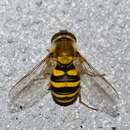Associations
provided by BioImages, the virtual fieldguide, UK
Animal / predator
larva of Syrphus vitripennis is predator of Aphidoidea
Plant / associate
larva of Syrphus vitripennis is associated with aphid-infested Acer pseudoplatanus
Conservation Status
provided by University of Alberta Museums
Common, not of concern.
- license
- cc-by-nc
- copyright
- University of Alberta Museums
Cyclicity
provided by University of Alberta Museums
Adult flight occurs between May and October across Canada.
- license
- cc-by-nc
- copyright
- University of Alberta Museums
Distribution
provided by University of Alberta Museums
Widespread throughout Canada, Alaska south to Colorado and Massachusetts, widespread in Europe and Asia (Vockeroth 1992).
- license
- cc-by-nc
- copyright
- University of Alberta Museums
General Description
provided by University of Alberta Museums
Approximately 6 to 14 mm in length, black and yellow body, with eye bare and face yellow. Distinguishing between S. vitripennis and S. ribesii is challenging, however S. ribesii has the bm cell with a small patch devoid of tiny hairs (i.e. not trichose, see A on image) (Gilbert 1986). However, male S. vitripennis are indistinguishable from male S. rectus. Yellow bands on tergites 3 and 4 are complete, curved posteriorly, and cover approximately half of the lateral margins (see B on image). Males: Hind femur is either brown to black, with only the apical one-quarter yellow (Vockeroth 1992).
- license
- cc-by-nc
- copyright
- University of Alberta Museums
Habitat
provided by University of Alberta Museums
Highly variable: boreal, mixed, and deciduous forest, parks, orchards, fields, and vineyards.
- license
- cc-by-nc
- copyright
- University of Alberta Museums
Life Cycle
provided by University of Alberta Museums
Syrphus vitripennis is probably multivoltine throughout most of its range, overwintering as a larva. However, there have been records of mass migrations over the Alps for this species, although the purpose of these migrations is unclear, since they occur throughout summer and fall (Schneider 1969). Aphidophagous and polyphagous, it is also an important regulator of natural aphid populations through much of its range. It has also been shown to demonstrate anti-parasitoid behaviours similar to those of S. ribesii (Rotheray 1981). Furthermore, under experimental conditions, S. vitripennis females increased the number of eggs they laid with increased densities of aphid colonies, indicating oviposition site selection for a more reliable food source for their offspring (Wnuk and Starmach 1977).
- license
- cc-by-nc
- copyright
- University of Alberta Museums
Trophic Strategy
provided by University of Alberta Museums
Larvae have been reported as feeding on Euceraphis sp. (Vockeroth 1992).
- license
- cc-by-nc
- copyright
- University of Alberta Museums
Syrphus vitripennis
provided by wikipedia EN
Syrphus vitripennis is a very common European and North American species of hoverfly. Its larvae feed on aphids[1]
Description
For terms see Morphology of Diptera
Wing length 7·25-10·25 mm. Frons above lunulae black. Tergites 3 and 4 with entire yellow bands and lateral margin of tergites black. Male: femora 3 black for basal three-quarters. Female: femora 3 black on basal two-thirds. The male genitalia and the larva are figured by Dusek and Laska (1964).[2] See references for determination.[3][4][5][6]
Distribution
Palearctic Throughout. Nearctic Alaska to California.[7][8] [9] Migratory.
Biology
Habitat: Deciduous and coniferous woodland and anthropophilic, occurring along field hedges, in suburban gardens and parks.[10] Flies March to October.
References
-
^ Stubbs, Alan E. & Falk, Steven J. (1983). British Hoverflies: An Illustrated Identification Guide. British Entomological & Natural History Society. p. 233, xvpp.
-
^ Dusek, J. & Laska, P. (1964) A contribution to distinguishing the European species of the subgenus Syrphus Fab. (Diptera, Syrphidae) according to the male genitalia and larvae. Acta Soc.Ent.Cechoslov., 61(1): 58-69.
-
^ Van Veen, M. (2004) Hoverflies of Northwest Europe: identification keys to the Syrphidae. 256pp. KNNV Publishing, Utrecht.addendum Archived 2017-02-07 at the Wayback Machine
-
^ Van der Goot,V.S. (1981) De zweefvliegen van Noordwest - Europa en Europees Rusland, in het bijzonder van de Benelux. KNNV, Uitgave no.32: 275pp. Amsterdam.
-
^ Bei-Bienko, G.Y. & Steyskal, G.C. (1988) Keys to the Insects of the European Part of the USSR, Volume V: Diptera and Siphonaptera, Part I. Amerind Publishing Co., New Delhi. ISBN 81-205-0080-6.
-
^ Coe, R.L. (1953) Diptera: Syrphidae. Handbks.ident.Br.insects, 10(1): 1-98. R.ent.Soc.London. pdf Archived 2018-10-04 at the Wayback Machine
-
^ "Fauna Europaea". Archived from the original on 2018-08-30. Retrieved 2017-01-21.
-
^ Peck, L.V. (1988) Syrphidae. In: Soos, A. & Papp, L. (eds.) Catalogue of Palaearctic Diptera, 8: 11-230. Akad.Kiado, Budapest.
-
^ Vockeroth, J. R. (1992). The Flower Flies of the Subfamily Syrphinae of Canada, Alaska, and Greenland (Diptera: Syrphidae). Part 18. The Insects and Arachnids of Canada. Ottawa, Ontario: Canadian Government Pub Centre. pp. 1–456. ISBN 0-660-13830-1.
-
^ Speight, M.C.D. (2011). "Species accounts of European Syrphidae (Diptera)" (PDF). Syrph the Net, the Database of European Syrphidae. 65: 285pp. Archived (PDF) from the original on 2016-03-04. Retrieved 2017-01-31.

- license
- cc-by-sa-3.0
- copyright
- Wikipedia authors and editors
Syrphus vitripennis: Brief Summary
provided by wikipedia EN
Syrphus vitripennis is a very common European and North American species of hoverfly. Its larvae feed on aphids
- license
- cc-by-sa-3.0
- copyright
- Wikipedia authors and editors

